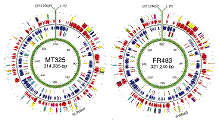Virology, Nebraska Center for
ORCID IDs
0000-0003-4101-4073
Date of this Version
2019
Citation
Viruses 2019, 11, 105
Abstract
Understanding HIV latent reservoirs in tissues is essential for the development of new strategies targeting these sites for eradication. Here, we assessed the size of latent reservoirs and the source of residual viruses in multiple lymphoid tissues of SIV-infected and fully suppressed rhesus macaques of Chinese-origin (cRMs). Eight cRMs were infected with SIVmac251 and treated with tenofovir and emtricitabine daily for 24 weeks initiated 4 weeks post-infection. Four of the eight animals reached sustained full viral suppression with undetectable viremia. The levels of cell-associated SIV DNA varied in peripheral blood mononuclear cells (PBMCs) and multiple lymphoid tissues, but with higher levels in the mesenteric lymph nodes (MesLNs). The levels of cell-associated SIV RNA also varied in different tissues. The higher frequency of viral RNA detection in the MesLNs was also observed by in situ hybridization. Consistently, the infection unit per million cells (IUPM) in the MesLNs was higher than in PBMCs and other tested lymphoid tissues by quantitative viral outgrowth assay (QVOA). Furthermore, env gp120 from tissue SIV RNA was amplified by single genome amplification. Phylogenetic analysis revealed diverse variants from tissues parallel to the viral inoculum in all viral suppressed animals. These results demonstrate that the latency and viral reservoirs in the lymphoid tissues still exist in aviremic macaques under full suppressive therapy. Moreover, the size of viral latent reservoirs differs in various lymphoid tissues with a relatively larger size in the MesLNs.
Included in
Biological Phenomena, Cell Phenomena, and Immunity Commons, Cell and Developmental Biology Commons, Genetics and Genomics Commons, Infectious Disease Commons, Medical Immunology Commons, Medical Pathology Commons, Virology Commons


Comments
© 2019 by the authors.
Open access
doi:10.3390/v11020105